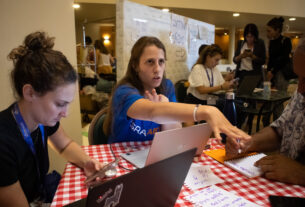“What lies behind us and what lies before us are tiny matters compared to what lies within us” – Ralph Waldo Emerson
‘);
_avp.push({ tagid: article_top_ad_tagid, alias: ‘/’, type: ‘banner’, zid: ThisAdID, pid: 16, onscroll: 0 });
Do you ever end (or start) the day feeling completely overwhelmed and exhausted by everything you have to do? Do you still worry that whatever you are doing – which is A LOT – is not enough?
Chances are, if you are a woman, you answered “yes!”
Sisters Emily and Amelia Nagoski explore the concept of burnout and its specific links to women’s health in their recent book, Burnout: The Secret to Unlocking the Stress Cycle. They write, “You’ve heard the usual advice over and over: exercise, green smoothies, self-compassion, coloring books, mindfulness, bubble baths, gratitude… You’ve probably tried a lot of it. So have we. And sometimes it helps, at least for a while. But then the kids are struggling in school or our partner needs support through a difficulty or a new work project lands in our laps, and we think, I’ll do the self-care thing as soon as I finish this.”
The sisters go on to describe how one of them ended up in the hospital, actually crippled by stress. While she believed she was having a heart attack, in reality her body was shutting down because of the intense amount of stress she was feeling, had felt, and likely was going to continue to feel. If stress was turning into a medical issue, she decided to look to science to understand how to solve, or at the very least, reduce the problem.
What they discovered is that most women try very hard to reduce their stress and take care of themselves. In fact, they try so hard they end up feeling stressed that they are not taking care of themselves enough!
They explain, “The problem is not that we aren’t trying. The problem isn’t that we don’t know how. The problem is the world has turned ‘wellness’ into yet another goal everyone ‘should’ strive for, but only people with time and money and nannies and yachts and Oprah’s phone number can actually achieve… this book is different from anything else you’ll read about burnout. We’ll figure out what wellness can look like in your real life, and we’ll confront the barriers that stand between you and your own well-being. We’ll put those barriers in context, like landmarks on a map, so we can find paths around and over and through them – or sometimes just blow them to smithereens.”
Burnout is a term that has three layers:
- emotional exhaustion – the fatigue that comes with caring too much, for too long.
- depersonalization – the depletion of empathy, caring, and compassion.
- decreased sense of accomplishment – an unconquerable sense of futility: feeling that nothing you do makes any difference.
There’s burnout all around us – particularly in the fields of education and medicine – especially in women. In addition, there is a growing body of research showing that parental burnout is increasing at an alarming rate.
What does science have to say about this phenomenon? And once we understand it, how can we fight it?
Our bodies are conditioned to respond in times of stress. For instance, if we see a lion approaching us, our bodies kick into high gear. Think of the lion as a “stressor,” something that begins the stress cycle. Seeing the lion makes you push blood to your muscles, makes your heart beat faster, and your blood pressure increase. If the stressor is a lion, you either get eaten or you get saved. If you get eaten, there’s nothing to talk about. If you get saved, it’s likely because you ran really far and really fast or because someone saved you. Both help calm the stress response in your body. The effort you put into running far and fast and the gratitude and connection you feel to those who saved you calms you down and allows you to complete the stress cycle.
What happens if the stressor is not a lion? What happens if the stressor is a really rude boss? What if he says something really unkind in the middle of a meeting? Your body still has the same response, you push blood to your muscles, make your heart beat faster, and your blood pressure increases. More likely than not, though, you are not able to get up and run far and fast. You are also not likely to be saved by friends. In that case, your body tenses, but there is no end to the stress cycle. As the authors put it, instead you are still “soaked in stress juice,” and this can happen day after day.
So, how can you ensure that you are not stewing in stress all day every day? How can you attempt to avoid burnout? The authors suggest two very effective ways:
Exercise. There’s a reason why you often feel so calm after you’ve exercised. There’s a real scientific reason why exercise is a stress reliever.
Affection. Spend time with people you love, especially those who you like to be close to. Feeling safe and secure around your loved ones can help complete the stress cycle.
Of course, nothing is foolproof, and there’s no easy solution, but burnout is tough, and we can all benefit from a little stress relief in our lives.
<!–
Publisher #16: JewishPress.com
Zone #113: Comment Banner / (02) / News
Size #15: Banner 468×60 (Comments and Mobile) [468×60]
–> ‘);
_avp.push({ tagid: article_top_ad_tagid, alias: ‘/’, type: ‘banner’, zid: ThisAdID, pid: 16, onscroll: 25 });




